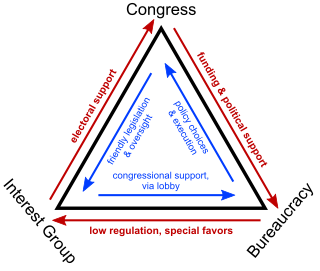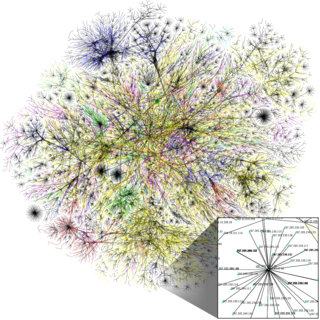Logrolling is the trading of favors, or quid pro quo, such as vote trading by legislative members to obtain passage of actions of interest to each legislative member. In organizational analysis, it refers to a practice in which different organizations promote each other's agendas, each in the expectation that the other will reciprocate. In an academic context, the Nuttall Encyclopedia describes logrolling as "mutual praise by authors of each other's work". Where intricate tactics or strategy are involved, the process may be called horse trading.
Public policy is an institutionalized proposal or a decided set of elements like laws, regulations, guidelines, and actions to solve or address relevant and real-world problems, guided by a conception and often implemented by programs. These policies govern and include various aspects of life such as education, health care, employment, finance, economics, transportation, and all over elements of society. The implementation of public policy is known as public administration. Public policy can be considered to be the sum of a government's direct and indirect activities and has been conceptualized in a variety of ways.
An epistemic community is a network of knowledge-based experts who help decision-makers to define the problems they face, identify various policy solutions and assess the policy outcomes. The definitive conceptual framework of an epistemic community is widely accepted as that of Peter M. Haas. He describes them as
"...a network of professionals with recognised expertise and competence in a particular domain and an authoritative claim to policy relevant knowledge within that domain or issue-area."
Good governance is the process of measuring how public institutions conduct public affairs and manage public resources and guarantee the realization of human rights in a manner essentially free of abuse and corruption and with due regard for the rule of law. Governance is "the process of decision-making and the process by which decisions are implemented ". Governance in this context can apply to corporate, international, national, or local governance as well as the interactions between other sectors of society.

In United States politics, the "iron triangle" comprises the policy-making relationship among the congressional committees, the bureaucracy, and interest groups, as described in 1981 by Gordon Adams. Earlier mentions of this ‘iron triangle’ concept are in a 1956 Congressional Quarterly Weekly Report as, “Iron triangle: Clout, background, and outlook” and “Chinks in the Iron Triangle?”
Agenda-setting theory suggests that the communications media, through their ability to identify and publicize issues, play a pivotal role in shaping the problems that attract attention from governments and international organizations, and direct public opinion towards specific issues. The theory suggests that the media can shape public opinion by determining what issues are given the most attention, and has been widely studied and applied to various forms of media. The way news stories and topics that impact public opinion are presented is influenced by the media. It is predicated on the idea that most individuals only have access to one source of information on most issues: the news media. Since they establish the agenda, they may affect how important some things are seen to be.

E-democracy, also known as digital democracy or Internet democracy, uses information and communication technology (ICT) in political and governance processes. The term is credited to digital activist Steven Clift. By using 21st-century ICT, e-democracy seeks to enhance democracy, including aspects like civic technology and E-government. Proponents argue that by promoting transparency in decision-making processes, e-democracy can empower all citizens to observe and understand the proceedings. Also, if they possess overlooked data, perspectives, or opinions, they can contribute meaningfully. This contribution extends beyond mere informal disconnected debate; it facilitates citizen engagement in the proposal, development, and actual creation of a country's laws. In this way, e-democracy has the potential to incorporate crowdsourced analysis more directly into the policy-making process.
Governance is the process of making and enforcing decisions within an organization or society. It encompasses decision-making, rule-setting, and enforcement mechanisms to guide the functioning of an organization or society. Effective governance is essential for maintaining order, achieving objectives, and addressing the needs of the community or members within the organization. Furthermore, effective governance promotes transparency, fosters trust among stakeholders, and adapts to changing circumstances, ensuring the organization or society remains responsive and resilient in achieving its goals. It is the process of interactions through the laws, social norms, power or language as structured in communication of an organized society over a social system. It is done by the government of a state, by a market, or by a network. It is the process of choosing the right course among the actors involved in a collective problem that leads to the creation, reinforcement, or reproduction of acceptable conduct and social order". In lay terms, it could be described as the processes that exist in and between formal institutions.
Global governance refers to institutions that coordinate the behavior of transnational actors, facilitate cooperation, resolve disputes, and alleviate collective action problems. Global governance broadly entails making, monitoring, and enforcing rules. Within global governance, a variety of types of actors – not just states – exercise power. Governance is thus broader than government.
Salience is the state or condition of being prominent. The Oxford English Dictionary defines salience as "most noticeable or important." The concept is discussed in communication, semiotics, linguistics, sociology, psychology, and political science. It has been studied with respect to interpersonal communication, persuasion, politics, and its influence on mass media.
In politics, a political agenda is a list of subjects or problems (issues) to which government officials as well as individuals outside the government are paying serious attention to at any given time.
Public administration theory refers to the study and analysis of the principles, concepts, and models that guide the practice of public administration. It provides a framework for understanding the complexities and challenges of managing public organizations and implementing public policies.
Governance is a broader concept than government and also includes the roles played by the community sector and the private sector in managing and planning countries, regions and cities. Collaborative governance involves the government, community and private sectors communicating with each other and working together to achieve more than any one sector could achieve on its own. Ansell and Gash (2008) have explored the conditions required for effective collaborative governance. They say "The ultimate goal is to develop a contingency approach of collaboration that can highlight conditions under which collaborative governance will be more or less effective as an approach to policy making and public management" Collaborative governance covers both the informal and formal relationships in problem solving and decision-making. Conventional government policy processes can be embedded in wider policy processes by facilitating collaboration between the public, private and community sectors. Collaborative Governance requires three things, namely: support; leadership; and a forum. The support identifies the policy problem to be fixed. The leadership gathers the sectors into a forum. Then, the members of the forum collaborate to develop policies, solutions and answers.
Network governance is "interfirm coordination that is characterized by organic or informal social system, in contrast to bureaucratic structures within firms and formal relationships between them. The concepts of privatization, public private partnership, and contracting are defined in this context." Network governance constitutes a "distinct form of coordinating economic activity" which contrasts and competes with markets and hierarchies.
Environmental politics designate both the politics about the environment and an academic field of study focused on three core components:
Environmental governance (EG) consists of a system of laws, norms, rules, policies and practices that dictate how the board members of an environment related regulatory body should manage and oversee the affairs of any environment related regulatory body which is responsible for ensuring sustainability (sustainable development) and manage all human activities—political, social and economic. Environmental governance includes government, business and civil society, and emphasizes whole system management. To capture this diverse range of elements, environmental governance often employs alternative systems of governance, for example watershed-based management. Obviously, in fact the EG arrangements are very diversed and not at all as inclusive as we could wish them to be.
Advocacy groups, also known as lobby groups, interest groups, special interest groups, pressure groups, or public associations, use various forms of advocacy or lobbying to influence public opinion and ultimate public policy. They play an important role in the development of political and social systems.

Collaborative e-democracy refers to a hybrid democratic model combining elements of direct democracy, representative democracy, and e-democracy. This concept, first introduced at international academic conferences in 2009, offers a pathway for citizens to directly or indirectly engage in policymaking. Steven Brams and Peter Fishburn describe it as an "innovative way to engage citizens in the democratic process," that potentially makes government "more transparent, accountable, and responsive to the needs of the people."
Multistakeholder governance is a practice of governance that employs bringing multiple stakeholders together to participate in dialogue, decision making, and implementation of responses to jointly perceived problems. The principle behind such a structure is that if enough input is provided by multiple types of actors involved in a question, the eventual consensual decision gains more legitimacy, and can be more effectively implemented than a traditional state-based response. While the evolution of multistakeholder governance is occurring principally at the international level, public-private partnerships (PPPs) are domestic analogues.
A governance failure refers to any failures of governance or ineffectiveness of governance processes.


